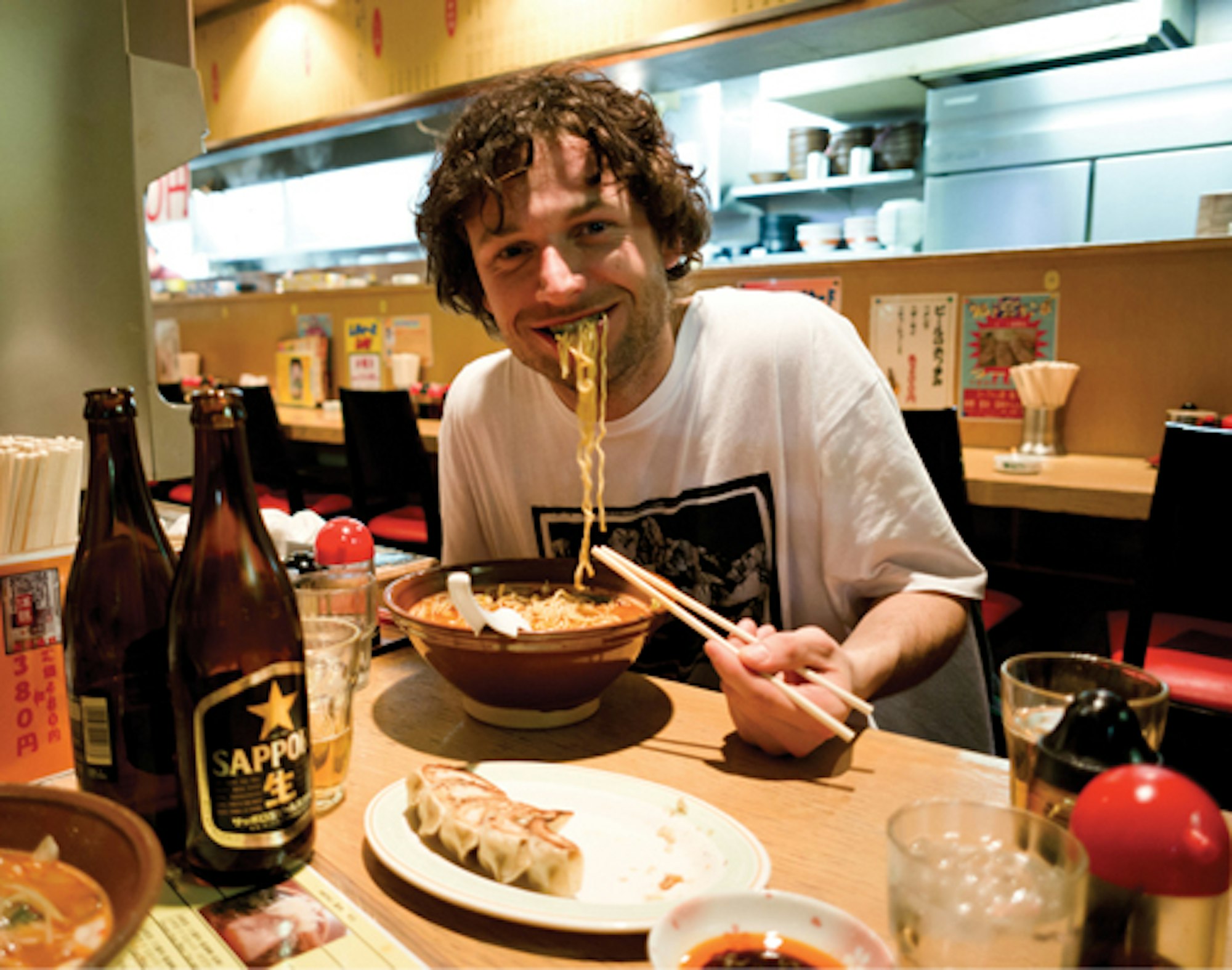Freeskier explores two sides of Japan and two sides of skiing Japan through the wild and frantic street stylings of Level 1’s jib crew and the classic pow-shredding of Nimbus Independent.
This article is featured in the December issue of FREESKIER. We present it on the web in two parts: Chris O’Connell’s experience with the Level 1 crew—shown here on this page—and Nate Abbott’s account of Nimbus’ trip, just one mouse-click away.
Part II: Barriers (Gallery above, words below)
Words and photos by Chris O’Connell
It was our second night in Sapporo, and it ended before it began. We had a couple of local ski kids guiding our group around as our real guides couldn’t join us. We had already hit the wide-bar down-flat-down rail setup a few times when the first two police officers arrived. And as soon as they did, our “guides” vanished. Our attempts to extinguish the situation entailed fake smiles and sign language negotiations. Then four more police officers arrived. No one in our crew spoke a word of Japanese, and the token English word uttered by the cops was “passport.” Within 15 minutes, a mellow 14 police officers were on scene and, while they were astonishingly polite, the situation seemed much gnarlier than what we were used to. Our entire crew, along with all of our gear—generator, lights, cameras, tri-pods—was corralled into a Japanese paddy wagon and driven away.
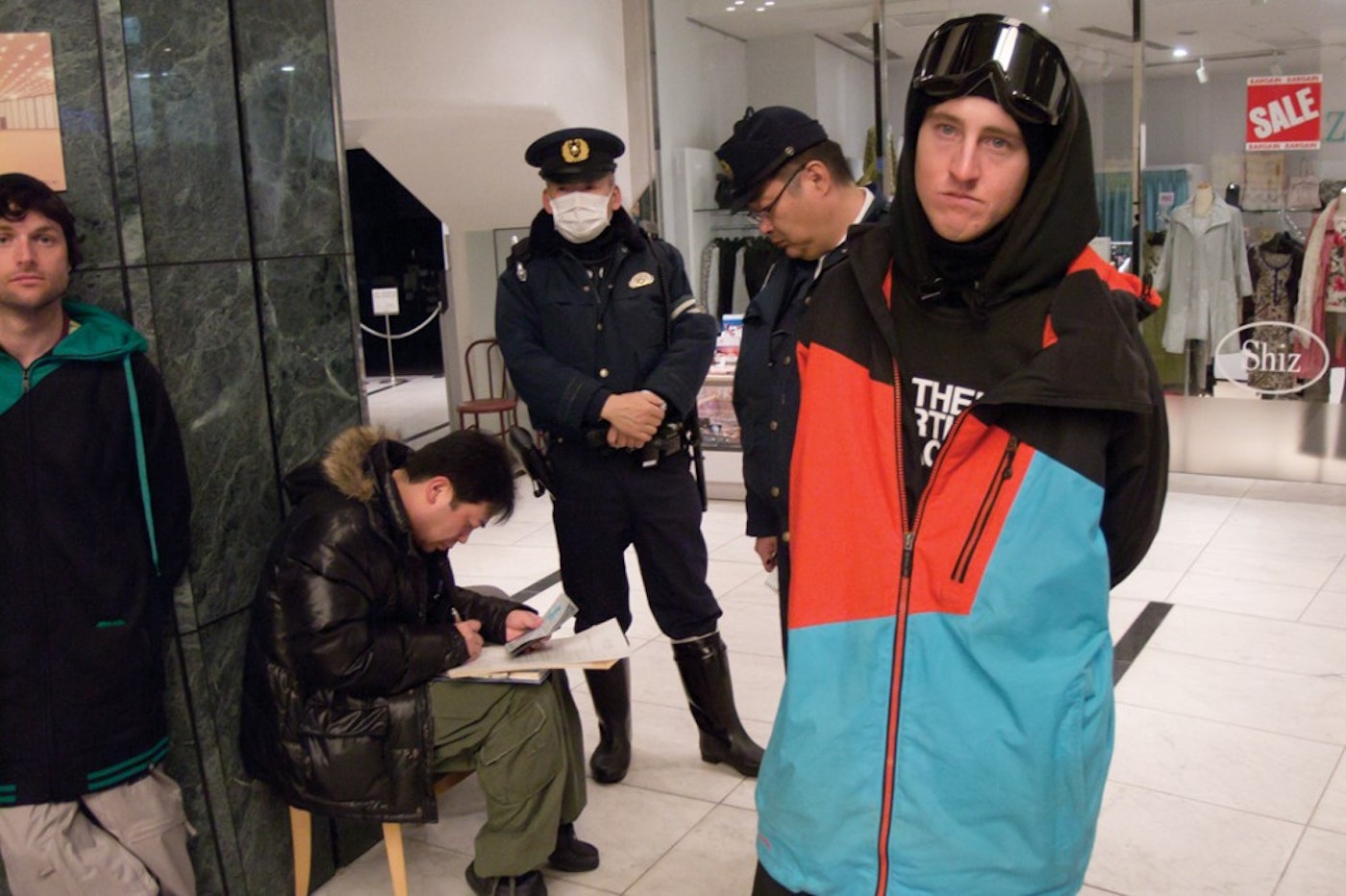
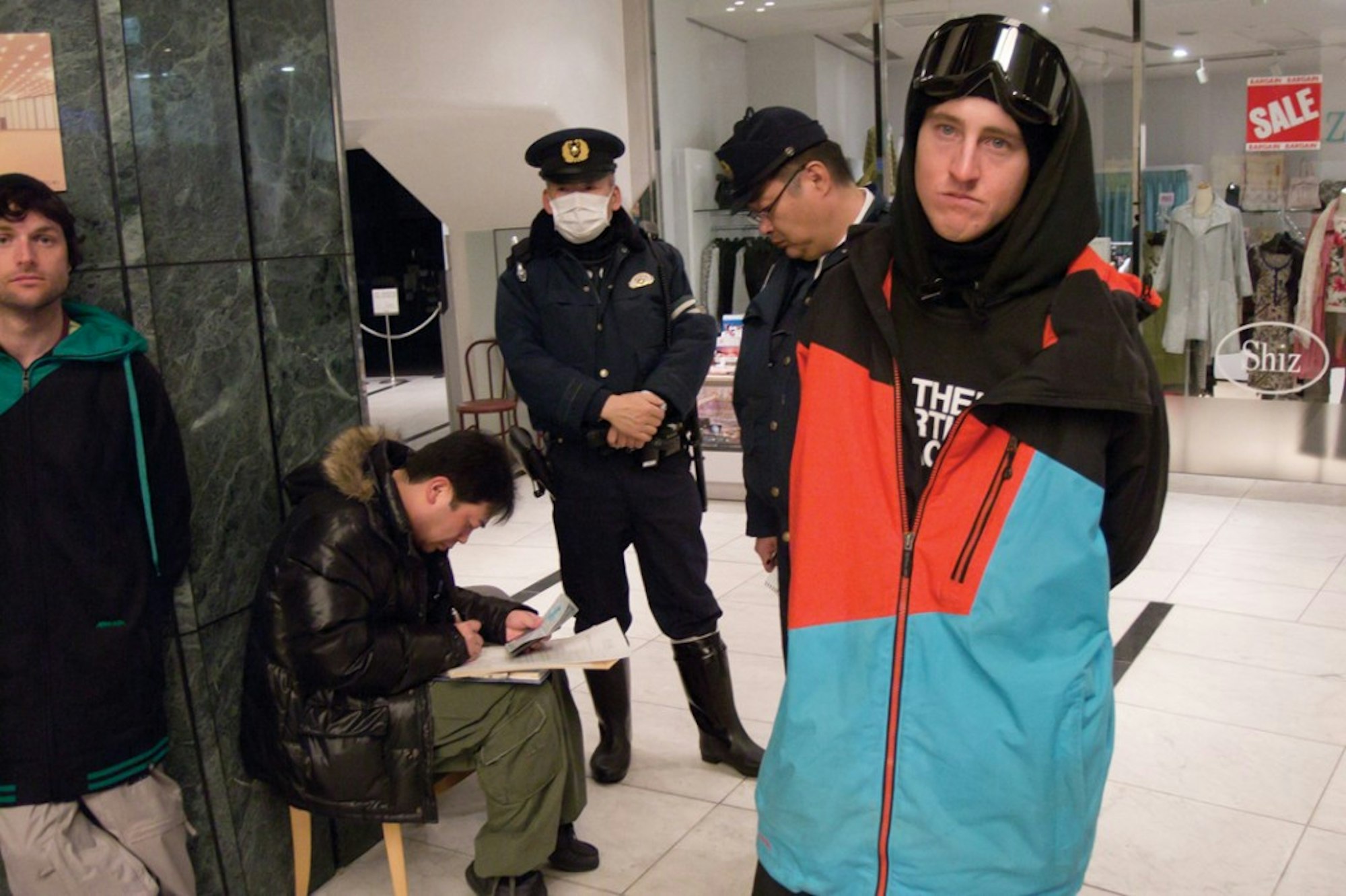
Hornbeck and Wallisch, thrilled to be hanging with the Japanese police.
While planning the trip, I neglected to inform the crew that a fellow photographer, and friend of mine, had been to Sapporo two weeks before with a snowboard crew and told me that the urban features were the biggest bust ever and we were going to spend a lot of time talking to the police. At the time, I felt that sharing this with the athletes and video guys was counterproductive; it could have swayed the decision on whether or not to make the trip. Banking on our inability to speak the language seemed a solid enough plan to keep us out of trouble. No need to trip anyone out before flying over 6,000 miles to slide down some metal.
Much later that evening, after a complete passport check by both uniformed and undercover police, we reconvened with our elusive “guides.” They then talked about the cops, informing us, “Japanese like foreigners, but they hate other Japanese.” They coupled that with the “little bit of weed” they had on them as the reason for their rapid departure. I conceded. In Japan, even 20 bucks worth of weed will land you in the slammer for easily a year. Japanese skiers rightfully keep their distance from police. So our trip moved to features further and further outside the city center to avoid the cops—a shame because, with its modern architecture, hilly landscape and frequent snowfall, Sapporo has more potential for urban shredding than anywhere in the world.
The northern Japanese island of Hokkaido is an absolute snow magnet. It’s rare that a January passes that isn’t all-time epic. Last winter, the calls from Japan started flooding my voicemail late in December, all claiming multiple 3-foot storms with no end to the storm cycle in sight. By New Year’s Eve, the mountains outside of Sapporo had received 20-plus feet—more snow than many of the world’s ski resorts receive in an entire year.
A sprawling urban landscape with over 2 million inhabitants buried in snow for most of the winter, Sapporo is the most populous snowlaced city in the world. With last winter shaping up to be exceptionally good, a few phone calls to Level 1 Productions were made and the dream jib crew, comprised of Tom Wallisch, Mike Hornbeck, and Alex Bellemare, was assembled and booked.
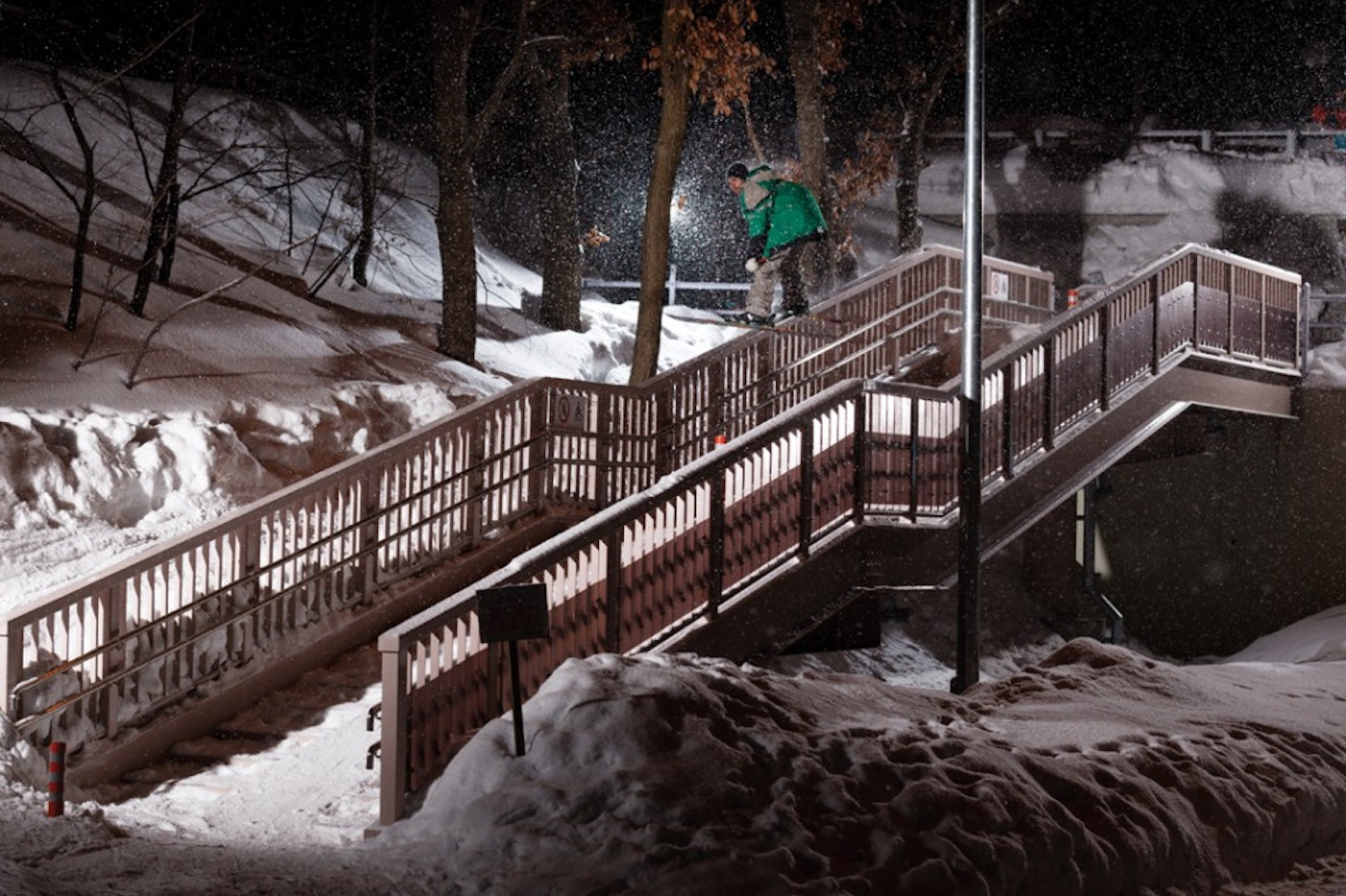
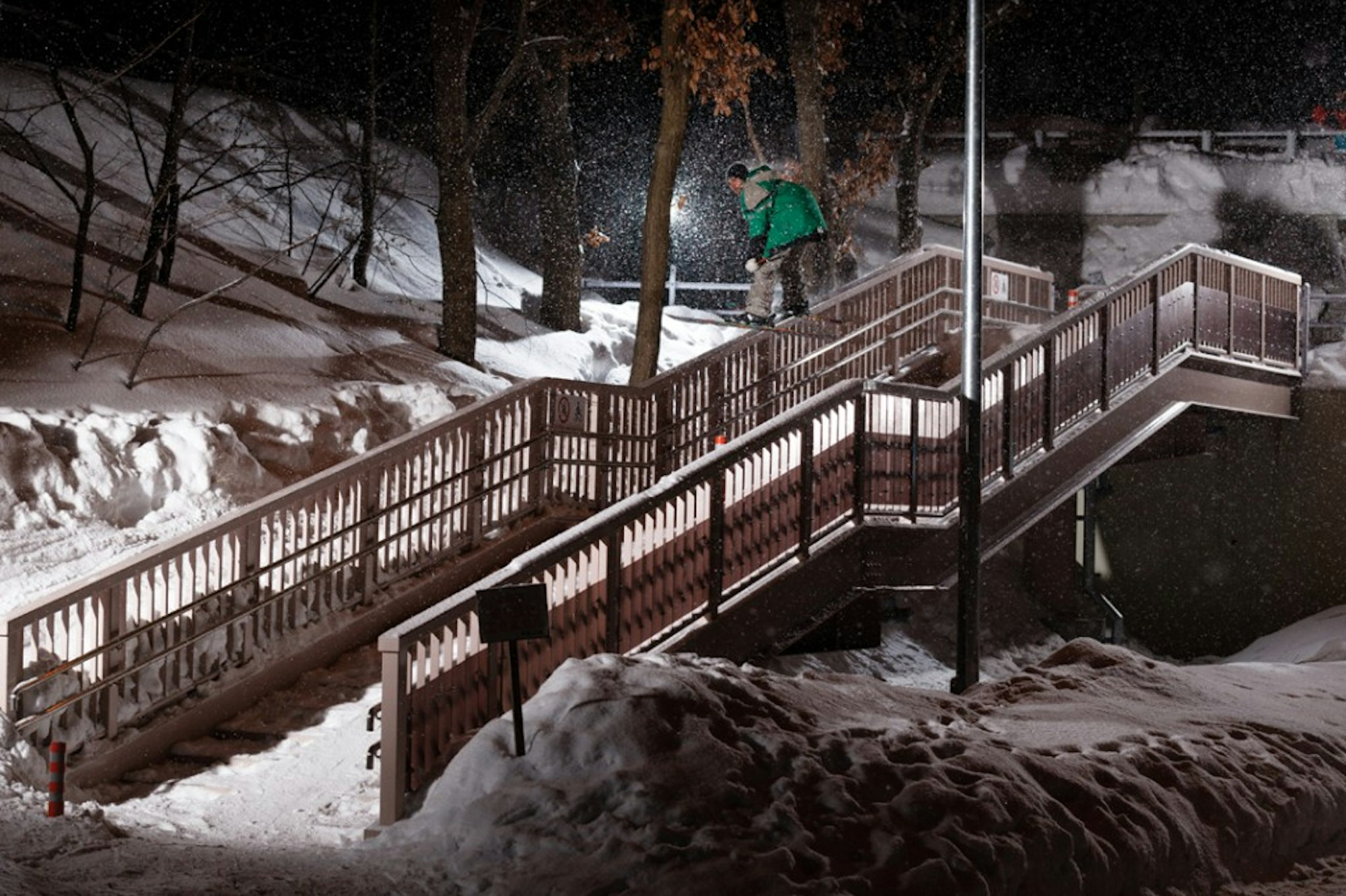
At the very least, if you’re going to get a ride in a paddy wagon, you should get a shot published in the magazine. Skier: Mike Hornbeck.
We convened at LAX, jumped over the Pacific to Tokyo, then up north to Sapporo. Nuclear reactors exhaling steam miles into the sky were visible from above during our Tokyo to Sapporo flight, which brought the Fukushima disaster to mind. Some people feel the radiation is blowing into Tokyo. “The government is lying to the people about how dangerous it really is,” a resident informed us. The surf break near Fukushima power plant has been rendered unsurfable for years to come—some 25,000 years—by the meltdown that followed the earthquake and tsunami of 2011. It was previously one of the more consistent and desirable surf breaks in Japan, but now it breaks empty of surfers. Adventure tourism in Japan could use a boost. That is the one thing on this topic that seems safe to say.
On our final approach to Sapporo, we could see man-made mountains of snow, larger than many resorts in the Midwwest, dotting the outskirts of the city. Those mountains turned out to be snow removed from the city by thousands of large dump trucks working around the clock, seven days a week. Some peaks towered over 200 feet and had trucks and excavators compressing and shaping them to allow for more heavy equipment to drive over them. These 21st century snow pyramids were not expected to completely melt until mid-July. The average city would be in a state of emergency from the meter plus of snow that fell during the one week we were in Japan, but Sapporo ran as silky smooth as New York City on a sunny April day.
Upon our arrival at Sapporo’s airport our guide, a skier named Bull, met us with a rental van stocked with generators and lights. Bull is one of Japan’s best all-around skiers and conveniently, he speaks very little English. Shredding bottomless pow in the mountains of Hokkaido and jumping off three-story buildings to very small transitions in Sapporo is Bull’s MO.
It took us very little time to realize that Bull was a loose cannon in a good way: crazy and ridiculously hilarious. Throwing dual peace signs, laughing and saying, “No Engrish!” then laughing more was his go-to expression. He lives in Breckenridge for the early part of each ski season and has an American girlfriend who speaks no Japanese. When I asked how they talked to each other, he held up his phone to show us Google Translate. You could call him the Mike Hornbeck of Japan: everyone loves him, and his hilarity and style trump all language barriers.
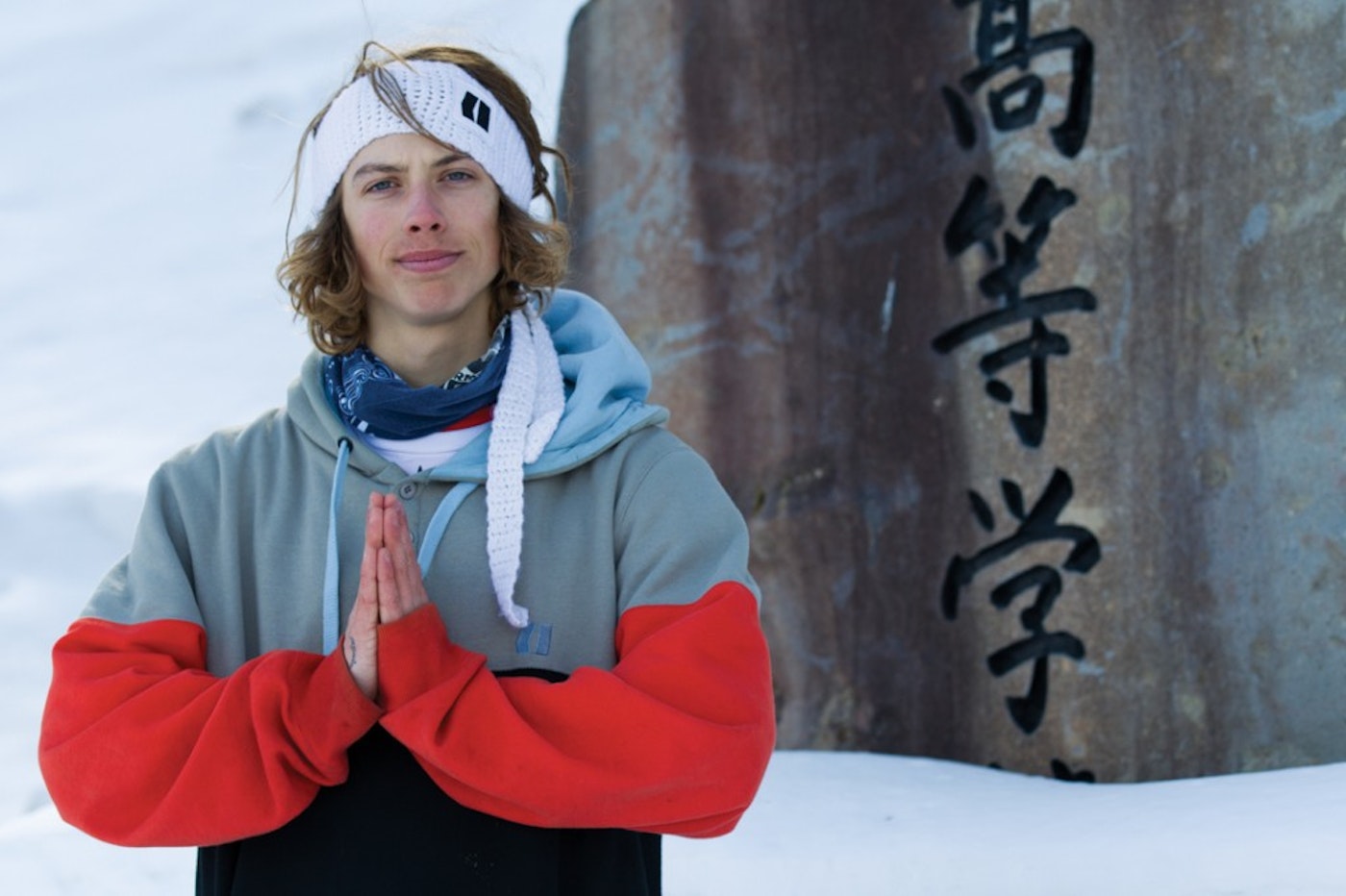
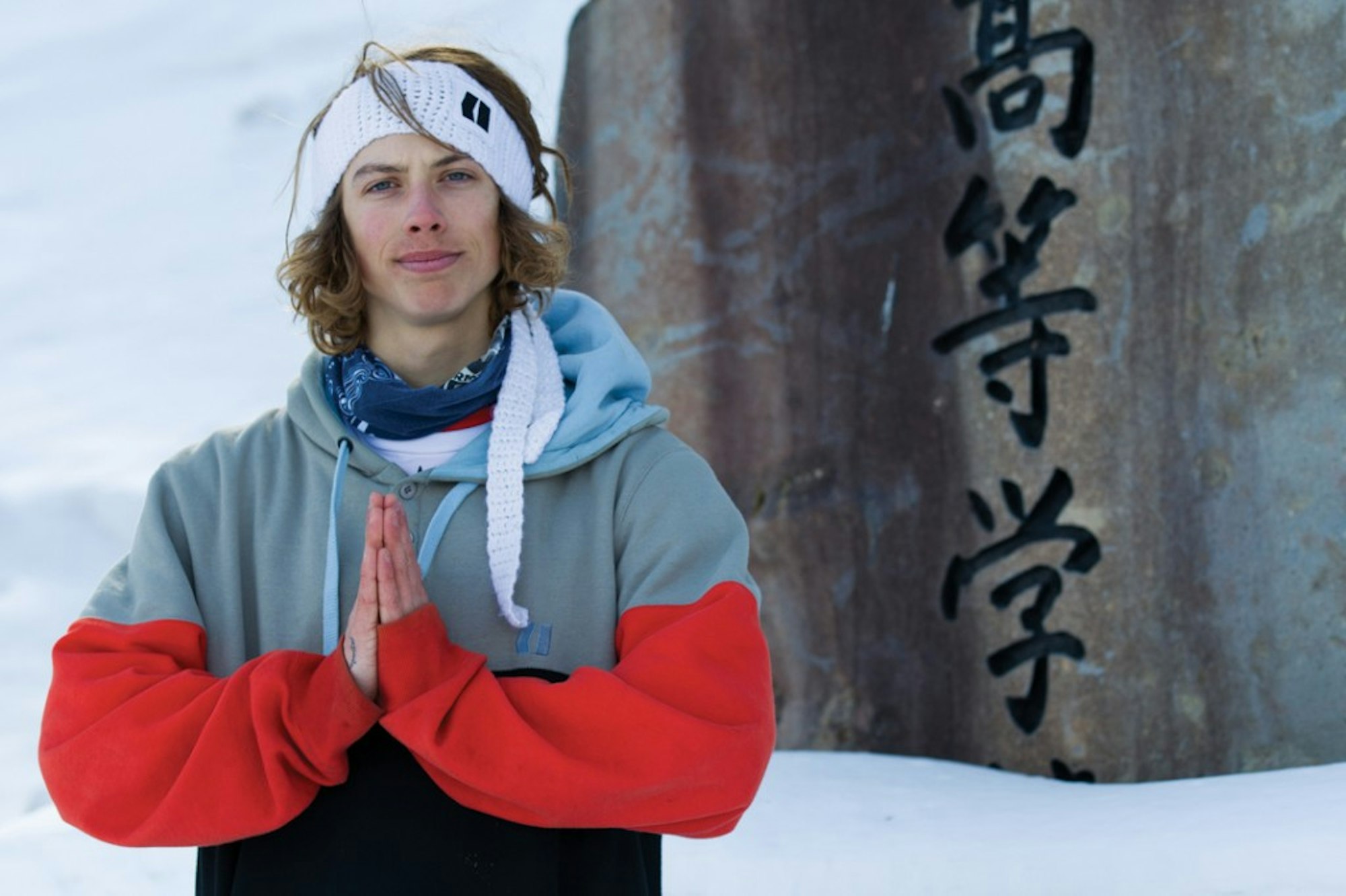
Alex Bellemare.
Bull was nursing four broken ribs from a ski stunt gone awry but was more than happy to drive us to the local spots, smiling the whole time. He instantly became the mascot of our voyage. He was so dialed in to his country, still in the formative years of freeskiing, that Hornbeck and Decker called in more of the Level 1 Productions bros from America to join them for another two weeks and stayed with Bull at his parent’s house to take advantage of the record-breaking snow year.
Following our release from custody, we had to come up with an explanation for our presence at the local urban jibs. Thanks to Hornbeck, the perfect solution fell into our laps the next day as we were preparing an urban gap jump on the grounds of a school. After being informed of our illicit activities by a few concerned locals, the school’s principal came out and asked us in Japanglish what was going on.
“We are making a movie to promote skiing and tourism in Japan,” Hornbeck deadpanned. “We love it here, and we want to encourage more Americans to visit Japan.” The rest of our crew joined in, embellishing our “tourist video” as we saw the demeanor of the mid-50-year-old man quickly change from suspicious and accusatory to interested and appreciative.
Evidenced by his willingness to concede, Japan has indeed had a very rough go of it in the tourism industry as of late, and everyone, including this principal, has felt it. It didn’t hurt that the high school was the alma mater of Japan’s only female Winter Olympic gold medalist, Tae Sotoya, who won the moguls title in 1998. The principal gladly let us hit the gap and even helped us by coordinating some students to pose underneath it for a photo.
Tom Wallisch proceeded to throw a huge double backflip over the gap, and Bellemare crushed some stylie rodeos. “Who needs to go to the backcountry when you can build kickers in the city?” Wally joked.
As a photographer, going on a rail trip with Tom Wallisch is sometimes a little frustrating. There isn’t much doubt that he’s king when it comes to gnarly, technical rails, but the switch ups he likes to do don’t always look so hot to us photo types. This trip Wally said that he was going to do a few rails “Hornbeck style.” “Hornbeck’s the most emulated skier in the world,” Tom said after he tail-to-nose pressed a down-flat rail with a foot-long gap.
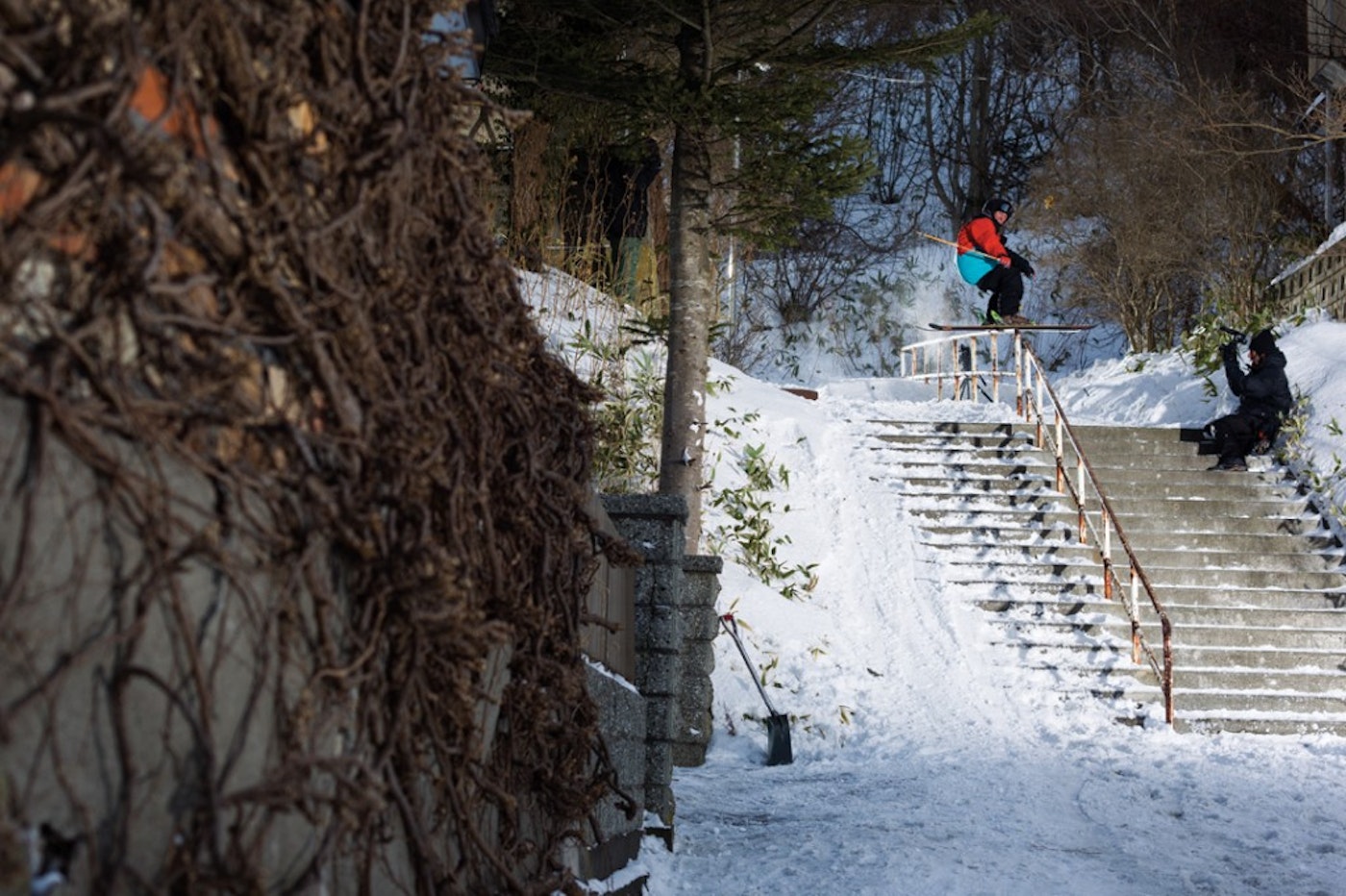
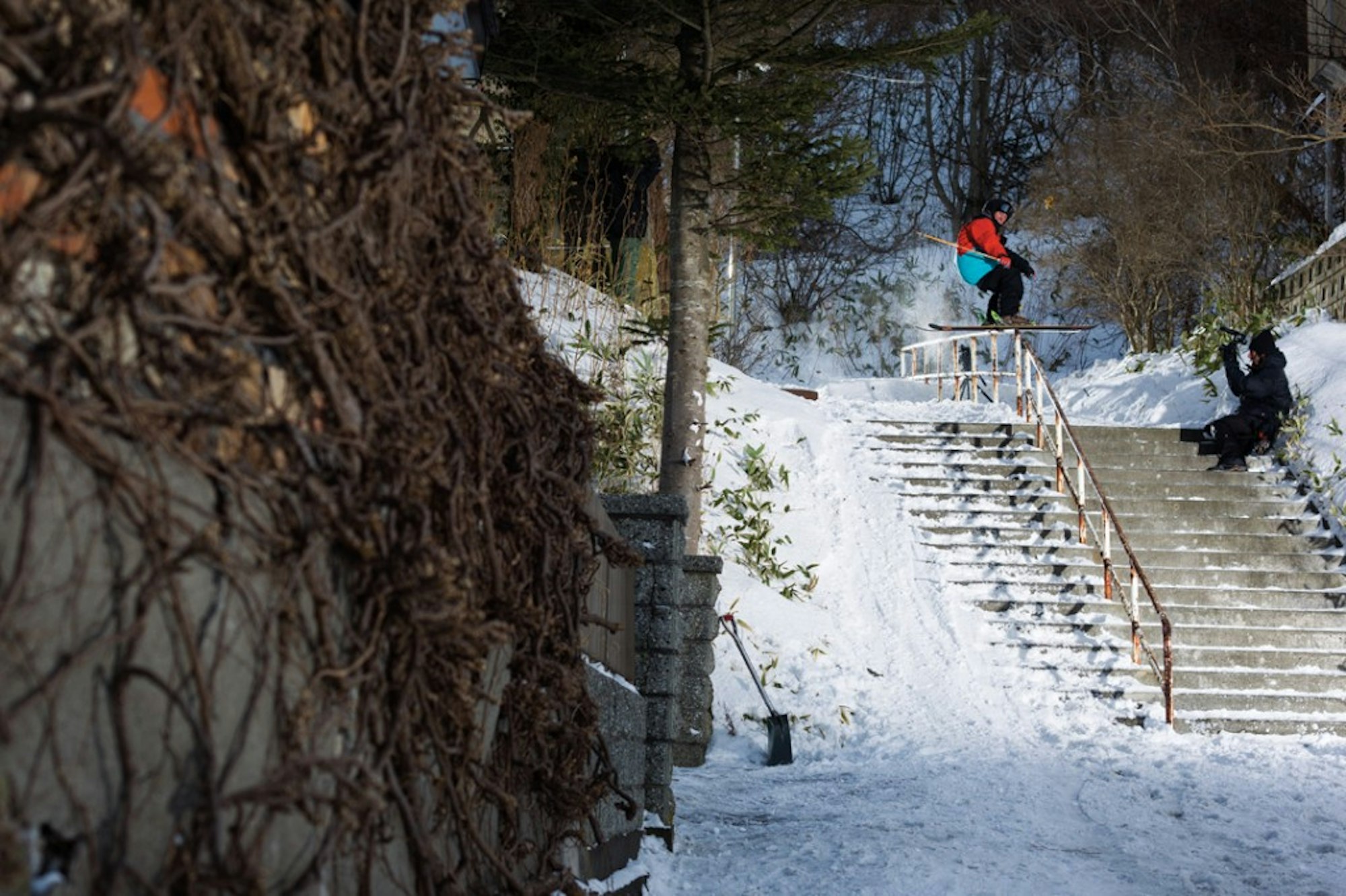
Tom Wallisch and his new puppy have something in common: they’re eager to please. On this flat-gap-down rail Wallisch pleased photographer Chris O’Connell with a simple layed–back slide on the flat before he skied up to O’Connell for a scratch behind the ears.
The best sight in Sapporo during the winter isn’t the annual Snow Festival, where they build multistory replicas of famous buildings such as the White House out of ice. Rather it is the miniskirts on the local female population in the blustery minus 15-degree nights. They all wear skirts shorter than most girls would wear during summer in Stockholm, with stiletto-heel boots to complete the outfit. The snow blows sideways and the girls flinch a bit, but it’s just another Tuesday midnight, and the streets are full of impressively long, well-kept legs. Japan is internationally known as an iconic country when it comes to style, but this takes it to another level. Hopefully Toronto, Helsinki, Ottawa and other cold, snowy cities will pick up on this aspect of culture. It would make a few million men a lot happier in the depths of winter. Just because you should be wearing a full length down parka and beanie doesn’t mean you should.
There are 1,033 Seicomart stores on the island of Hokkaido. The crew stopped every day at a Seicomart, sometimes twice a day. Think 7-Eleven with more interesting snacks, a huge liquor selection and great Japanese schoolgirl magazines. This was Bellemare’s first international trip, and he was diving right in, eating all kinds of crazy dried fish and weird shit from Seicomart. He also got the award for being the only one in the group to eat pureed raw crab brains. Yum.
Although the Quebecer Bellemare is only 18 years old, he’s already secured the cover of Level 1 Productions’ After Dark, which was the first major ski movie he appeared in. Bellemare is part of the new guard of freestyle kids. He grew up in the park, has mentors like Phil Casabon and absolutely crushes all things technical and street. He’s got a quirky sense of humor and comes off a little spacey, but he’s not. “The kid’s the real deal,” Hornbeck claimed about Alex. “He’s just crazy enough to be really good, and he makes everyone laugh, so I am sure he’ll be staying around.”
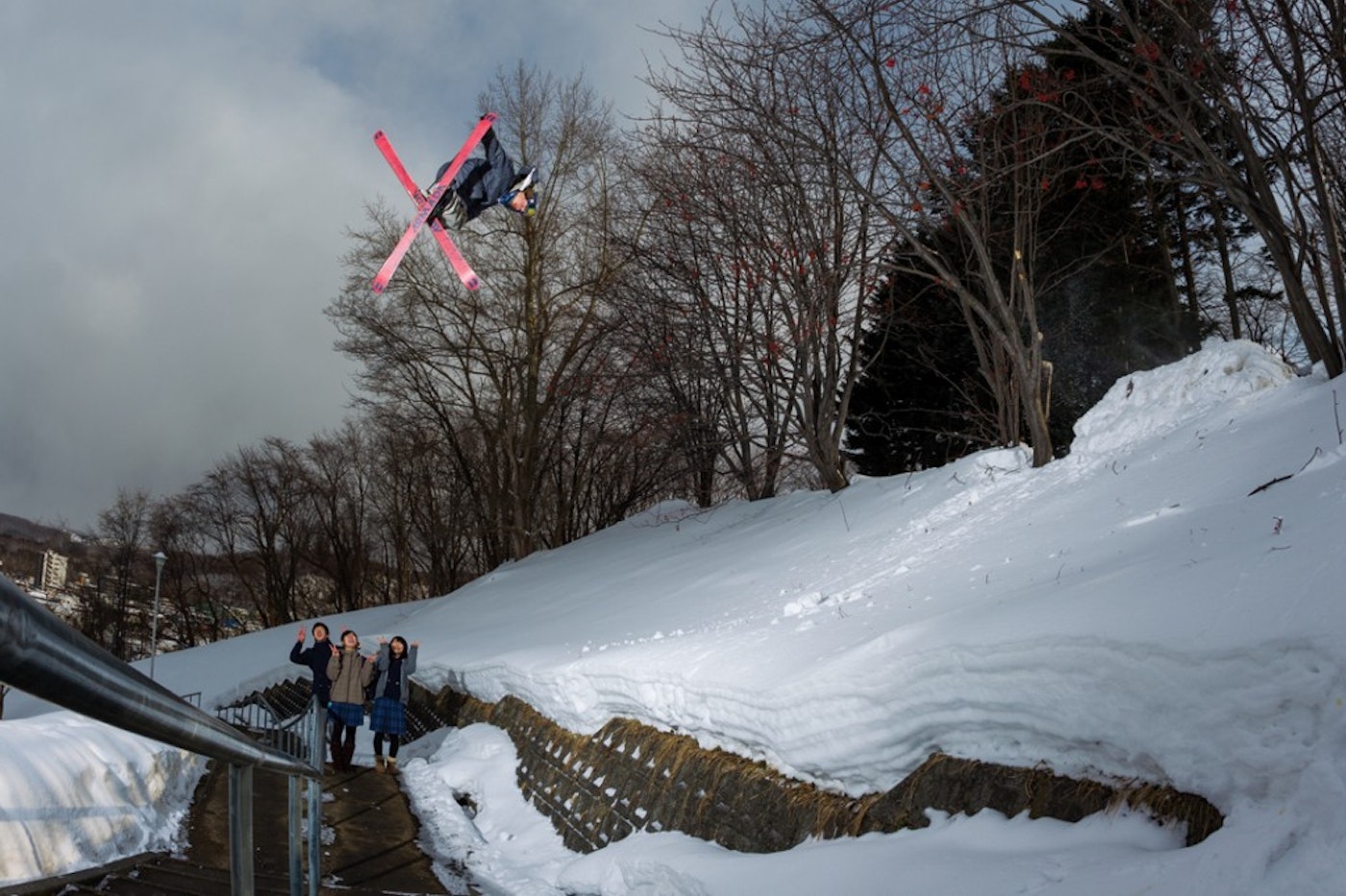
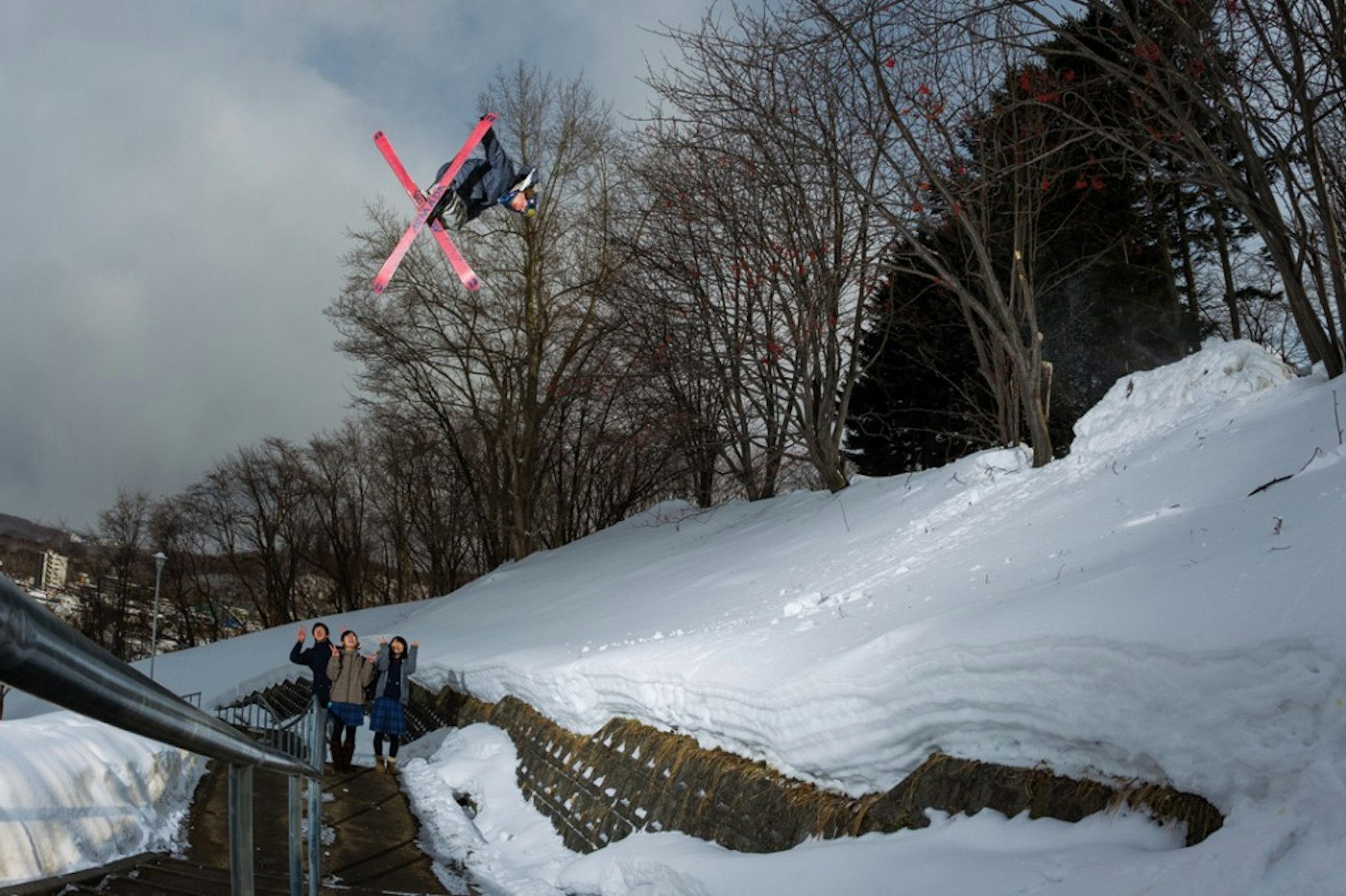
Is Alex Bellemare a pacifist? Who knows? But doesn’t the crossed-up tail grab 360 he’s throwing match up well with the double peace signs his fans are throwing back at him?
The last day of the trip brought us to a pair of tall, rectangular cement structures off the side of a road on the outskirts of town, near where Bull was born and raised. Surrounded by nothing but farmland, the structures were probably used to store grains like rice. Hornbeck and Bellemare went wild doing tow-in wall rides with Bull behind the wheel of the minivan, gunning it to about 80 kph for the lofty, elongated wall. Bellemare crushed it in a few tries and sat down. Hornbeck rocked out numerous still and video shots. But Wallisch just sat there, took it all in and cheered on the other two. Wally sitting out a feature is a rarity, for sure.
When all was done with the boys’ wall riding, Wally climbed to the top of one tower, looked out at the other and said he thought it would go. The “it” was a transfer from one tower across a sizeable gap, landing on the vertical wall of the other tower with a 4-foot-tall snow transition built at the bottom. If it were up to me, I wouldn’t have allowed him to hit the feature. I don’t need people getting broke off on shoots. I am getting too old and the kids are getting too damn good. The consequences of missteps on some urban features have gotten to be as serious as a wrong turn in Alaska, and this transfer feature was foreboding.
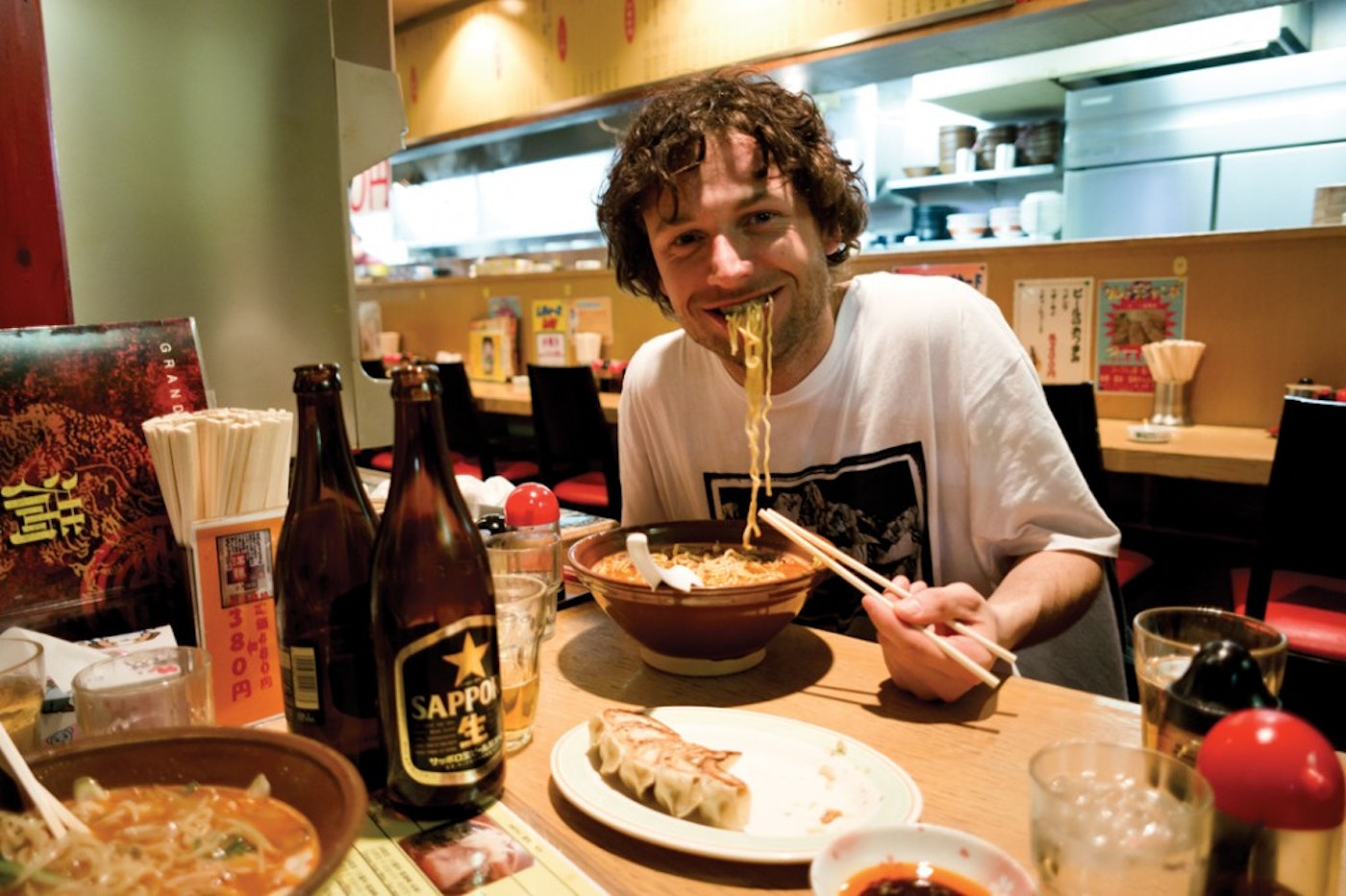
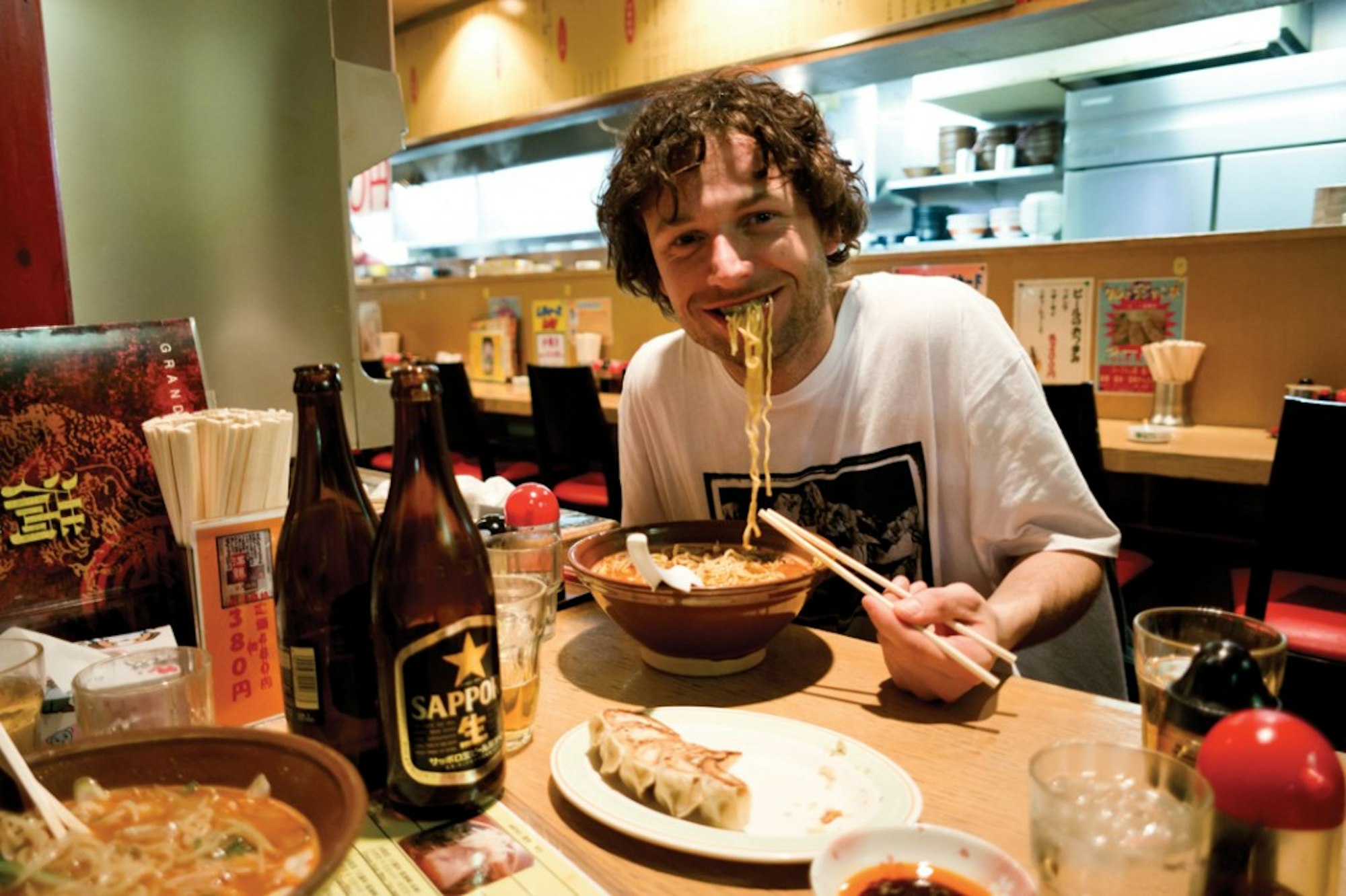
Hornbeck and a mouthful.
Tom sized it up and called for the bungee to spring him into the feature. I still thought it was insane, but considering that many of the most consequential urban features done in the past few years have Tom’s stamp of ownership on them, I held my tongue and shot. Even Kyle Decker, Tom’s primary filmer, held his breath for this one.
We could tell that even Tom was a bit nervous, but he nailed it first try with just a little wheelie out. It was game on, and Tom hit it a half dozen more times. Just before the sun set on our time in Sapporo, he had the shot of the trip in the can. “That’s the gnarliest urban feature I have ever hit,” he claimed—a heavy comment from Mr. Wallisch.
Another quest came to an end for our crew, and we couldn’t help but think, “Maybe we’ll make a movie about our time in Sapporo so more Americans go there to visit.”

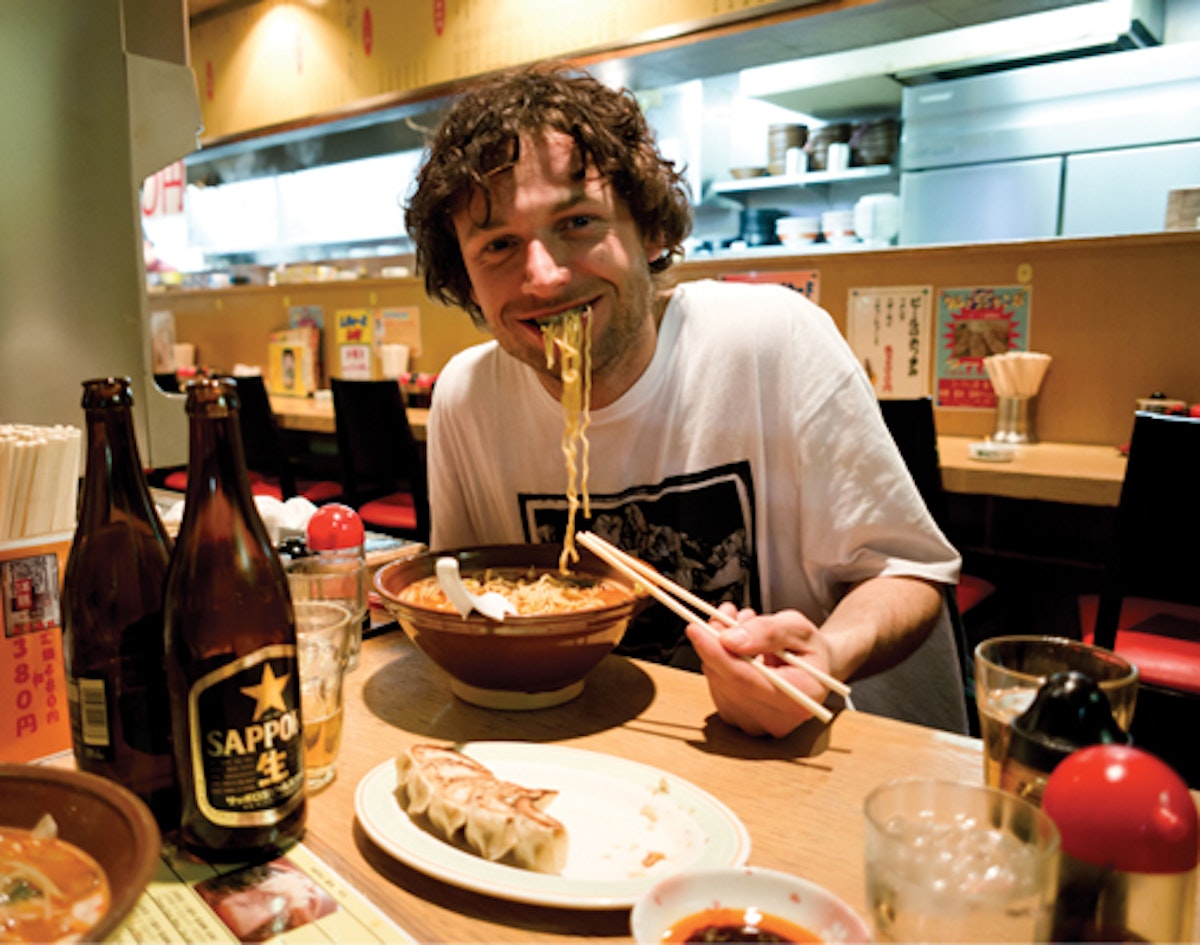
![[GIVEAWAY] Win a Head-to-Toe Ski Setup from IFSA](https://www.datocms-assets.com/163516/1765920344-ifsa.jpg?w=200&h=200&fit=crop)
![[GIVEAWAY] Win a Legendary Ski Trip with Icelantic's Road to the Rocks](https://www.datocms-assets.com/163516/1765233064-r2r26_freeskier_leaderboard1.jpg?w=200&h=200&fit=crop)

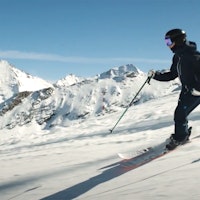
![[GIVEAWAY] Win a Legendary Ski Trip with Icelantic's Road to the Rocks](https://www.datocms-assets.com/163516/1765233064-r2r26_freeskier_leaderboard1.jpg?auto=format&w=400&h=300&fit=crop&crop=faces,entropy)




![[GIVEAWAY] Win a Head-to-Toe Ski Setup from IFSA](https://www.datocms-assets.com/163516/1765920344-ifsa.jpg?auto=format&w=400&h=300&fit=crop&crop=faces,entropy)


